Potřebujeme váš souhlas k využití jednotlivých dat, aby se vám mimo jiné mohly ukazovat informace týkající se vašich zájmů. Souhlas udělíte kliknutím na tlačítko „OK“.
ASTM F2927-12
Standard Test Method for Door Systems Subject to Airblast Loadings (Withdrawn 2021)
Automaticky přeložený název:
Standardní zkušební metoda pro dveřní systémy, které podléhají Airblast zatížením
NORMA vydána dne 1.10.2012
Informace o normě:
Označení normy: ASTM F2927-12
Poznámka: NEPLATNÁ
Datum vydání normy: 1.10.2012
Kód zboží: NS-54747
Počet stran: 11
Přibližná hmotnost: 33 g (0.07 liber)
Země: Americká technická norma
Kategorie: Technické normy ASTM
Kategorie - podobné normy:
Anotace textu normy ASTM F2927-12 :
Keywords:
airblast rating, blast capacity, blast door assembly, door response damage categories, effective positive, glazing, glazing hazard levels, glazing system, phase duration, peak positive pressure, positive phase impulse, reflected airblast pressure damage, vision lite, ICS Number Code 91.060.50 (Doors and windows)
Doplňující informace
| Significance and Use | ||
|
5.1 This test method provides standardized procedures that must be followed to establish that a particular door assembly meets a defined damage category. Test results can be used to specify a door assembly for a particular pressure/time loading and damage level. 5.2 Establish a door design and, if applicable its glazing system, subjected to this test method does not imply that door systems of similar design will resist the applied test load. The probability that a single door assembly will resist the specified air blast pressure for which it is certified increases with the number of test specimens used to certify the door design. See 1.1 This test method identifies the standard procedures that shall be followed when utilizing either a shock tube or a controlled open-air explosion to evaluate the blast capacity of a door system. This test method is designed for all types of swinging doors, including single and double doors construction. This method is used to test complete door assemblies. A door assembly includes the door panel(s), latching hardware, hinges, post mullion (if applicable), frame and frame connection to a rigid reaction structure. The door panel(s) may also contain one or more integral vision lites (glazing systems). The glazing system may include, but not be limited to those fabricated from monolithic glass, laminated glass, plastic, glass-clad plastics, glass/plastic glazing materials, and filmed-backed glass. The results gathered from this method can be used for door installations in non-rigid wall openings. The test method may be adapted to horizontal sliding and vertical-lift doors. 1.2 The scaled range or standoff of the charge shall be 1 m (3 ft, 3 in.) or greater from the specimen in order to reduce or eliminate any punching effect the blast may have on the specimen. A charge-in-contact blast test is not covered by this method. 1.3 This test method and the resulting data are valid for the door size tested and smaller doors of identical construction. Acceptance criteria are divided into five Door Response Damage Categories (Categories I, II, III, IV and V). Refer to section Damage Rating |
Description of Door / Frame Response |
Damage Level Category |
|
Undamaged |
The door specimen is substantially unchanged after the airblast loading and is fully operable. Any permanent deformation shall be within 3 mm (1/8 in.) of the pretest condition. The door must be checked that it is operable by unlatching and swinging the door open and then closed and latched. The door can be secured. The external portion of the frame, frame anchorage, latches, and hinges shall not show any visible damage. If strain gauges were used, the recorded stresses in the door material are within the specifier’s acceptable limits. |
I |
|
Damaged but Openable |
The door panel, the frame, and/or the hardware has acceptable permanent deformation or damage; however, the door remains openable. The door must be checked that it is openable by unlatching and swinging the door open far enough to allow ingress / egress. Acceptable permanent deformation or damage and degree of opening to permit ingress / egress is determined by the specifier based on the end use of the door. |
II |
|
Non-catastrophic Failure |
The door may get lodged into the frame from the blast force or the door may swing open in rebound. The door may be inoperable and may hinder ingress / egress. Acceptable permanent deformation or damage is determined by the specifier based on the end use of the door. The door and hardware components are not permitted to detach from the frame and be thrown into the test structure witness area. The frame and frame anchorage must remain and integral system and attached to the test structure wall. |
III |
|
Limited Hazard Failure |
The door leaf becomes separated frame or the frame anchorage fails and the entire door leaf and frame assembly become separated from the test structure wall and are thrown into the test structure witness area. The dislodged door leaf or assembly must remain within the 3 m (120 in.) finish floor as shown in IV |
|
|
High Hazard Failure |
The door leaf becomes separated frame or the frame anchorage fails and the entire door leaf and frame assembly become separated from the test structure wall and are thrown into the test structure witness area and strikes the witness panel above the “High Hazard Threshold” shown in Fig. 1. There shall be no evidence of any dislodged hardware component striking the witness panel above the High Hazard Threshold. |
V |
1.4 A door assembly may also contain ancillary hardware such as pulls, closers, kickplates, coordinators, gaskets, etc. Although these hardware components may not influence blast resistance performance, the specifier may wish to verify that these items do not dislodge from the door or frame during a test and become a flying debris hazard.
1.5 For doors equipped with a vision lite, the door shall be evaluated using the Door Response Damage Categories introduced in section 1.3 and defined in Table 1 and the glazing and glazing system of the vision lite shall also be evaluated using a
Hazard Rating
Description of Door’s Glazing Response
Hazard Level
No Break
The glazing is observed not to fracture and there is no visible damage to the glazing system.
H1
No Hazard
The glazing is observed to fracture but is fully retained in the door’s vision lite frame and the rear surface (the side opposite the airblast loaded side of the specimen) is unbroken.
H1
Minimal Hazard
The glazing is observed to fracture and the total length of tears in the glazing plus the total length of pullout from the edge of the vision lite frame is less than 20 % of the glazing sight perimeter. Also, there are three or less perforations caused by glazing slivers and no fragment indents anywhere in a vertical witness panel located 3 m (120 in.) from the interior face of the specimen and there are fragments with a sum total united dimension of 25 cm (10 in.) or less on the floor between 0 m to 1 m (0 in. to 40 in.) from the interior face of the specimen. Glazing dust and slivers are not accounted for in the rating. Fragments are defined as any particle with a united dimension of 2.5 cm (1 in.) or greater. The united dimension of a glass particle is deter- mined by adding its width, length, and thickness. Glazing dust and slivers are all smaller particles.
H2
Very Low Hazard
The glazing is observed to fracture within 1 m (40 in.) of the original location. Also, there are three or less perforations caused by glazing slivers and no fragment indents anywhere in a vertical witness panel located 3 m (120 in.) from the interior face of the specimen and there are fragments with a sum total united dimension of 25 cm (10 in.) or less on the floor between 1 m (40 in.) and 3 m (120 in.) from the interior face of the specimen. Glazing dust and slivers are not accounted for in the rating.
H3
Low Hazard
The glazing is observed to fracture, but the glazing fragments generally fall between 1 m (40 in.) of the interior face of the specimen and 50 cm (20 in.) or less above the floor of a vertical witness panel located 3 m (120 in.) from the interior face of the specimen. Also, there are ten or fewer perforations in the area of a vertical witness panel located 3 m (120 in.) from the interior face of the specimen and higher than 50 cm (20 in.) above the floor and none of the perforations penetrate through the full thickness of the foil backed insulation board layer of the witness panel.
H4
High Hazard
Glazing is observed to fracture and there are more than ten perforations in the area of a vertical witness panel located 3 m (120 in.) from the interior face of the specimen and higher than 50 cm (20 in.) above the floor or there are one or more perforations in the same witness panel area with fragment penetration through the first layer and into the second layer of the witness panel.
N/A
1.6 This method is intended to test the blast capacity of a door assembly from a shock wave. It does not attempt to address all testing required of door assemblies. These tests may include, but are not limited to, charge-in-contact blast resistance, forced entry resistance, bullet resistance, fire resistance, sound attenuation, and gas or water leakage. These types of tests are not covered by this test method.
1.7 This test method does not verify the blast performance of the wall that a tested door will be placed in.
1.8 The values stated in SI units (International System of Units) are to be regarded as the standard. The values given in parentheses are provided for information only.
1.9 This standard does not purport to address all of the safety concerns, if any, associated with its use. It is the responsibility of the user of this standard to establish appropriate safety and health practices and determine the applicability of regulatory limitations prior to use.
|
ISO/IEC International Standard 17025 |
General Requirements for the Competence of Testing and Calibration Laboratories |
|
Standard Specification for Agencies Involved in Testing, Quality Assurance, and Evaluating of Manufactured Building Components |
|
|
Standard Test Method for Glazing and Glazing Systems Subject to Airblast Loadings |


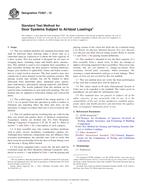
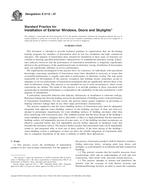 ASTM E2112-07
ASTM E2112-07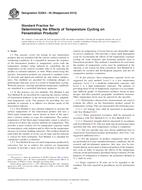 ASTM E2264-05(2013)..
ASTM E2264-05(2013)..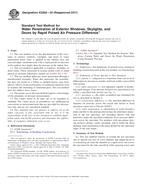 ASTM E2268-04(2011)..
ASTM E2268-04(2011)..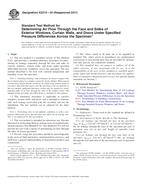 ASTM E2319-04(2011)..
ASTM E2319-04(2011)..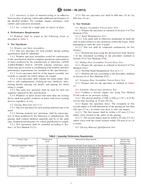 ASTM E2395-06(2013)..
ASTM E2395-06(2013)..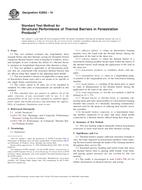 ASTM E2692-10
ASTM E2692-10
 Cookies
Cookies
